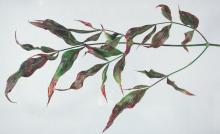Cause Mosaic symptoms may be due to any of 3 viruses including cucumber mosaic virus (CMV), plantago asiatica mosaic virus (formerly nandina mosaic virus) and/or nandina stem pitting virus (NSPV). All of these viruses are easily transmitted through vegetative propagation of the host. CMV can also be vectored by a wide variety of aphids. None are seed transmitted.
Symptoms CMV - Wine red discoloration of new spring growth. Leaves are thinner than normal, like 'shoestrings,' and often cupped downward. Flower buds on plants may be pink. There may be fewer buds and fewer berries set as a result.
Plantago asiatica mosaic virus - A mild mosaic that does not persist in the plant. There may be stunting and leaf distortion.
NSPV - Leaf distortion, mosaic, leaf reddening and an upward leaf roll and stem pitting. No stunting is involved.
Note that leaf reddening can also be due to increased light intensity or a wound response to nonviral pathogens.
Cultural control
- Select and plant only virus-tested (and found to be free of all known viruses) stock.
- Grow stock from seed.
- Rogue out and destroy affected plants.
- Control insect (See the PNW Insect Management Handbook for details) vectors.
References Hughes, P.L., Harper, F., Zimmerman, M.T., and Scott, S. W. 2005. Nandina mosaic virus is an isolate of plantago asiatica mosaic virus. European Journal of Plant Pathology 113:309-313.
Simone, G.W. Nandina diseases. In: Jones, R.K. and Benson, D.M. (eds.) 2001. Diseases of Woody Ornamentals and Trees in Nurseries. St. Paul, MN: APS Press.

